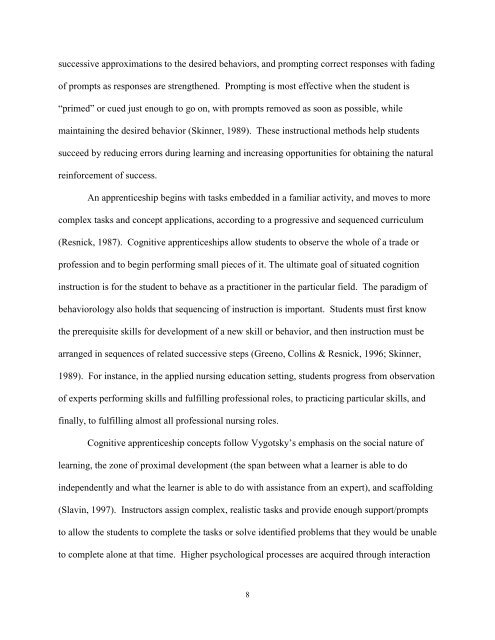STUDENT EVALUATION OF CLINICAL EDUCATION ENVIRONMENT
STUDENT EVALUATION OF CLINICAL EDUCATION ENVIRONMENT
STUDENT EVALUATION OF CLINICAL EDUCATION ENVIRONMENT
You also want an ePaper? Increase the reach of your titles
YUMPU automatically turns print PDFs into web optimized ePapers that Google loves.
successive approximations to the desired behaviors, and prompting correct responses with fading<br />
of prompts as responses are strengthened. Prompting is most effective when the student is<br />
“primed” or cued just enough to go on, with prompts removed as soon as possible, while<br />
maintaining the desired behavior (Skinner, 1989). These instructional methods help students<br />
succeed by reducing errors during learning and increasing opportunities for obtaining the natural<br />
reinforcement of success.<br />
An apprenticeship begins with tasks embedded in a familiar activity, and moves to more<br />
complex tasks and concept applications, according to a progressive and sequenced curriculum<br />
(Resnick, 1987). Cognitive apprenticeships allow students to observe the whole of a trade or<br />
profession and to begin performing small pieces of it. The ultimate goal of situated cognition<br />
instruction is for the student to behave as a practitioner in the particular field. The paradigm of<br />
behaviorology also holds that sequencing of instruction is important. Students must first know<br />
the prerequisite skills for development of a new skill or behavior, and then instruction must be<br />
arranged in sequences of related successive steps (Greeno, Collins & Resnick, 1996; Skinner,<br />
1989). For instance, in the applied nursing education setting, students progress from observation<br />
of experts performing skills and fulfilling professional roles, to practicing particular skills, and<br />
finally, to fulfilling almost all professional nursing roles.<br />
Cognitive apprenticeship concepts follow Vygotsky’s emphasis on the social nature of<br />
learning, the zone of proximal development (the span between what a learner is able to do<br />
independently and what the learner is able to do with assistance from an expert), and scaffolding<br />
(Slavin, 1997). Instructors assign complex, realistic tasks and provide enough support/prompts<br />
to allow the students to complete the tasks or solve identified problems that they would be unable<br />
to complete alone at that time. Higher psychological processes are acquired through interaction<br />
8












